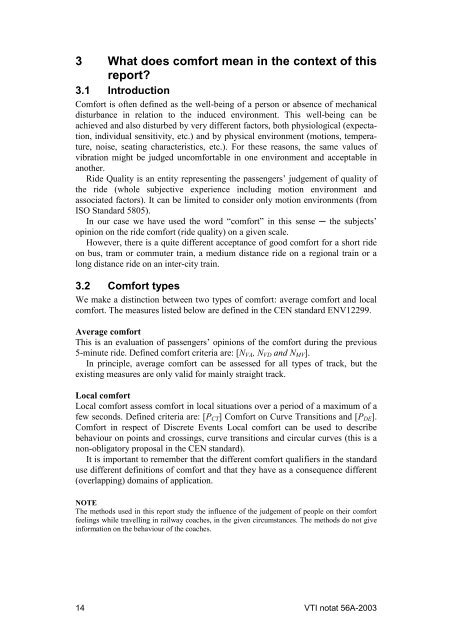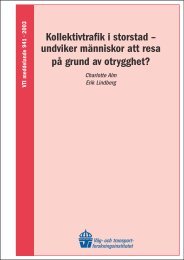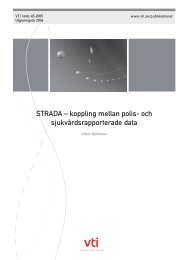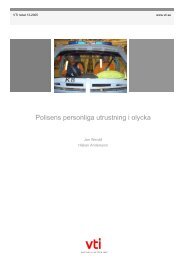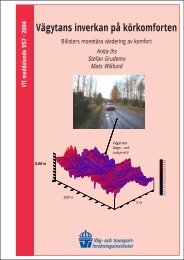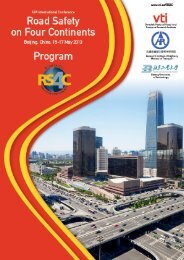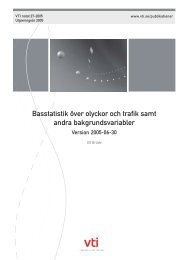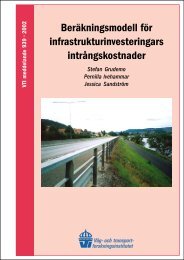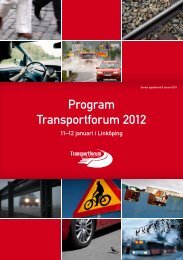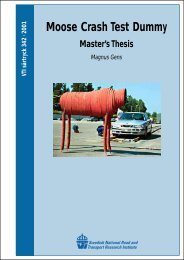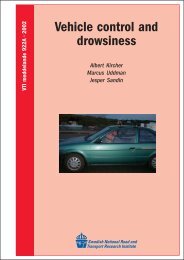UIC comfort tests - VTI
UIC comfort tests - VTI
UIC comfort tests - VTI
You also want an ePaper? Increase the reach of your titles
YUMPU automatically turns print PDFs into web optimized ePapers that Google loves.
3 What does <strong>comfort</strong> mean in the context of thisreport?3.1 IntroductionComfort is often defined as the well-being of a person or absence of mechanicaldisturbance in relation to the induced environment. This well-being can beachieved and also disturbed by very different factors, both physiological (expectation,individual sensitivity, etc.) and by physical environment (motions, temperature,noise, seating characteristics, etc.). For these reasons, the same values ofvibration might be judged un<strong>comfort</strong>able in one environment and acceptable inanother.Ride Quality is an entity representing the passengers’ judgement of quality ofthe ride (whole subjective experience including motion environment andassociated factors). It can be limited to consider only motion environments (fromISO Standard 5805).In our case we have used the word “<strong>comfort</strong>” in this sense ─ the subjects’opinion on the ride <strong>comfort</strong> (ride quality) on a given scale.However, there is a quite different acceptance of good <strong>comfort</strong> for a short rideon bus, tram or commuter train, a medium distance ride on a regional train or along distance ride on an inter-city train.3.2 Comfort typesWe make a distinction between two types of <strong>comfort</strong>: average <strong>comfort</strong> and local<strong>comfort</strong>. The measures listed below are defined in the CEN standard ENV12299.Average <strong>comfort</strong>This is an evaluation of passengers’ opinions of the <strong>comfort</strong> during the previous5-minute ride. Defined <strong>comfort</strong> criteria are: [N VA , N VD and N MV ].In principle, average <strong>comfort</strong> can be assessed for all types of track, but theexisting measures are only valid for mainly straight track.Local <strong>comfort</strong>Local <strong>comfort</strong> assess <strong>comfort</strong> in local situations over a period of a maximum of afew seconds. Defined criteria are: [P CT ] Comfort on Curve Transitions and [P DE ].Comfort in respect of Discrete Events Local <strong>comfort</strong> can be used to describebehaviour on points and crossings, curve transitions and circular curves (this is anon-obligatory proposal in the CEN standard).It is important to remember that the different <strong>comfort</strong> qualifiers in the standarduse different definitions of <strong>comfort</strong> and that they have as a consequence different(overlapping) domains of application.NOTEThe methods used in this report study the influence of the judgement of people on their <strong>comfort</strong>feelings while travelling in railway coaches, in the given circumstances. The methods do not giveinformation on the behaviour of the coaches.14 <strong>VTI</strong> notat 56A-2003


